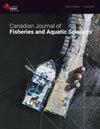利用 SSN 和 INLA 进行溪流温度统计建模:面向保护工作者的介绍
IF 2.2
2区 农林科学
Q2 FISHERIES
Canadian Journal of Fisheries and Aquatic Sciences
Pub Date : 2024-03-12
DOI:10.1139/cjfas-2023-0136
引用次数: 0
摘要
加拿大渔业与水产科学杂志》,提前出版。 预测水温细尺度空间分布(即 "热景观")的统计溪流温度模型可以指导水生物种恢复和栖息地恢复工作。然而,由于树枝状网络中采样点的非独立性所导致的空间自相关性,使得溪流温度建模变得复杂。我们利用部署在加拿大落基山溪流中的微型传感器提供的八月平均温度数据,展示了两种考虑空间自相关性的溪流温度统计建模技术。第一种是空间蒸汽网络(SSN)模型,专门用于考虑树枝状溪流网络中的空间自相关性。第二个是综合嵌套拉普拉斯近似(INLA)模型,该模型考虑了空间自相关性,但并非针对各向异性流网络数据而设计。我们使用 "留一 "交叉验证法评估了最合适的 SSN 和 INLA 模型。与 INLA 相比,SSN 模型的 RMSE 更低(1.23 对 1.45 C),r2 更高(0.71 对 0.61);但是,SSN 模型在纳入空间相关随机误差之前需要更多的预处理步骤。我们提供了实用建议、开放存取的 r 脚本和数据,以帮助非专业人员开发统计流温模型。本文章由计算机程序翻译,如有差异,请以英文原文为准。
Statistical stream temperature modelling with SSN and INLA: an introduction for conservation practitioners
Canadian Journal of Fisheries and Aquatic Sciences, Ahead of Print.
Statistical stream temperature models predicting the fine-scale spatial distribution of water temperatures (i.e., “thermalscape”) can guide aquatic species recovery and habitat restoration efforts. However, stream temperature modelling is complicated by spatial autocorrelation arising from non-independence of sampling sites within dendritic networks. We used August mean temperature data from miniature sensors deployed in Canadian Rocky Mountain streams to demonstrate two statistical stream temperature modelling techniques that account for spatial autocorrelation. The first was a spatial steam network (SSN) model specifically developed to account for spatial autocorrelation in dendritic stream networks. The second was an integrated nested Laplace approximation (INLA) model that accounts for spatial autocorrelation but was not designed to address anisotropic stream network data. We evaluated the best-fitting SSN and INLA models using leave-one-out cross-validation. Relative to INLA, SSN models had lower RMSE (1.23 vs. 1.45 C) and higher r2 (0.71 vs. 0.61); however, the SSN models required more preprocessing steps before incorporating spatially correlated random errors. We provide practical advice, an open-access r-script, and data to help non-experts develop statistical stream temperature models.
Statistical stream temperature models predicting the fine-scale spatial distribution of water temperatures (i.e., “thermalscape”) can guide aquatic species recovery and habitat restoration efforts. However, stream temperature modelling is complicated by spatial autocorrelation arising from non-independence of sampling sites within dendritic networks. We used August mean temperature data from miniature sensors deployed in Canadian Rocky Mountain streams to demonstrate two statistical stream temperature modelling techniques that account for spatial autocorrelation. The first was a spatial steam network (SSN) model specifically developed to account for spatial autocorrelation in dendritic stream networks. The second was an integrated nested Laplace approximation (INLA) model that accounts for spatial autocorrelation but was not designed to address anisotropic stream network data. We evaluated the best-fitting SSN and INLA models using leave-one-out cross-validation. Relative to INLA, SSN models had lower RMSE (1.23 vs. 1.45 C) and higher r2 (0.71 vs. 0.61); however, the SSN models required more preprocessing steps before incorporating spatially correlated random errors. We provide practical advice, an open-access r-script, and data to help non-experts develop statistical stream temperature models.
求助全文
通过发布文献求助,成功后即可免费获取论文全文。
去求助
来源期刊

Canadian Journal of Fisheries and Aquatic Sciences
农林科学-海洋与淡水生物学
CiteScore
4.60
自引率
12.50%
发文量
148
审稿时长
6-16 weeks
期刊介绍:
The Canadian Journal of Fisheries and Aquatic Sciences is the primary publishing vehicle for the multidisciplinary field of aquatic sciences. It publishes perspectives (syntheses, critiques, and re-evaluations), discussions (comments and replies), articles, and rapid communications, relating to current research on -omics, cells, organisms, populations, ecosystems, or processes that affect aquatic systems. The journal seeks to amplify, modify, question, or redirect accumulated knowledge in the field of fisheries and aquatic science.
 求助内容:
求助内容: 应助结果提醒方式:
应助结果提醒方式:


